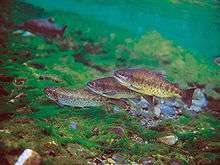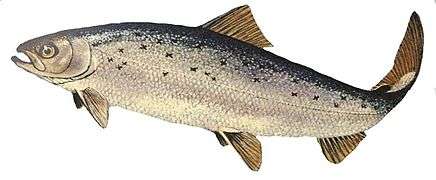Oncorhynchus masou formosanus
| Oncorhynchus masou formosanus | |
|---|---|
 | |
| Scientific classification | |
| Kingdom: | Animalia |
| Phylum: | Chordata |
| Class: | Actinopterygii |
| Order: | Salmoniformes |
| Family: | Salmonidae |
| Genus: | Oncorhynchus |
| Species: | Oncorhynchus masou |
| Subspecies: | O. m. formosanus |
| Trinomial name | |
| Oncorhynchus masou formosanus (D. S. Jordan & Ōshima, 1919) | |
Oncorhynchus masou formosanus, the Formosan landlocked salmon[1] or Taiwanese salmon, is a freshwater salmonid fish endemic to Taiwan.
The Formosan landlocked salmon is a subspecies of the more widespread West-Pacific cherry salmon (or masu salmon). This Taiwanese subspecies is critically endangered, being at high risk for extinction, and is protected in its native habitat. The Formosan land-locked salmon is one of the rarest fish in the world. Once a staple of the Taiwanese aborigine diet, there are now barely more than 400 of this type of salmon left. Overfishing has led to its decline. Conservationists are trying to save this subspecies which is threatened nowadays mainly by pollution.
Formosan landlocked salmon are about a foot in length and inhabit cold, slow-flowing streams with gently sloping beds at elevations above 1,500 metres (4,900 ft), such as the Chichiawan Stream and the Kaoshan Stream (formerly named Hsuehshan Stream/Wuling Stream) in the upper reaches of the Tachia River.
The taxonomic rank of the endemic Taiwanese salmon is in dispute.[2] Some authors consider it not distinct from the nominate cherry salmon (O. masou masou), others as a regional subspecies O. masou formosanus, and still others list is as a full species O. formosanus.
At this time, these salmon represent the southernmost natural distribution of members of the family Salmonidae in Asia.
Notes
- ↑ Yan HY (2000) Threatened fishes of the world: Oncorhynchus masou formosanus (Jordan & Oshima, 1919) (Salmonidae) Environmental Biology of Fishes 57:314.
- ↑ Kottelat, M. 1996. Oncorhynchus formosanus. 2006 IUCN Red List of Threatened Species. Downloaded on 12 December 2010.
References
- Froese, Rainer, and Daniel Pauly, eds. (2010). Oncorhynchus masou formosanus in FishBase. April 2010 version.

